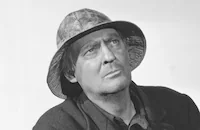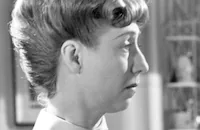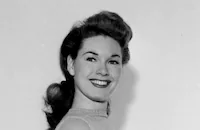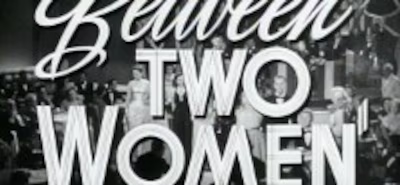Between Two Women

Brief Synopsis
Cast & Crew
Willis Goldbeck
Van Johnson
Lionel Barrymore
Gloria Dehaven
Keenan Wynn
Marilyn Maxwell
Film Details
Technical Specs

Synopsis
When his wheelchair-bound, irascible boss, Dr. Leonard B. Gillespie, insists that he take his place at a gala war bond event, hard-working, young physician Randall "Red" Adams reluctantly agrees. To Red's surprise, Dr. Gillespie's wealthy "date" turns out to be Ruth Edley, a sincere socialite whose determination to marry Red is the cause of much gossip at his New York hospital, Blair General. After Red informs Ruth that, although he loves her, he cannot marry her because of her money, his attention is caught by Edna, a singer at the nightclub. Red tells the jealous Ruth that he senses something "peculiar" about Edna, and shortly after, Edna falls unconscious in her dressing room and is rushed to Blair by Red. The next morning, Red questions the revived Edna about her life, and she reveals that she has been unable to eat anything for four days. Red diagnoses Edna with neuropsychiatric self-starvation, but cannot say why she has developed a sudden loathing for food. At the same time, Sally, the hospital's beloved switchboard operator, falls ill after complaining for days about feeling tired and sick. Red diagnoses Sally with Bright's disease, an incurable but controllable urinary condition. Red then returns to Edna's nightclub to question her co-workers about recent events that may have contributed to her illness. Red does his best to uncover useful information about Edna, but learns nothing. Ruth, however, smugly tells Red that he is not asking the right questions and has a chat with Edna's dancer friend Marian. Based on their conversation, Ruth then suggests to Red that Edna's problems may be connected to her boyfriend's former admirer, Sylvia. Following Ruth's lead, Red returns to the hospital with Sylvia's theatrical agent, Goff, and drills Edna about her relationship with Sylvia, a dancer at the club. Edna states that after she became involved with her boyfriend, she and a jealous Sylvia began to fight, and Sylvia was eventually fired. Sometime later, Sylvia, a known drinker, died from starvation, and after hearing the news, Edna stopped eating. At Red's urging, the agent then reveals that Sylvia was fired after giving the stage manager an ultimatum, and did not starve because she lacked money, but because she was drinking too much. Convinced now that she was in no way responsible for Sylvia's death, Edna declares herself cured and looks forward to her next meal. Sally, meanwhile, is experiencing great pain, and Red is forced to reconsider his diagnosis. Upon examining some X-rays, Red concludes that she has a blocked kidney and requires emergency surgery. Sally, who feared she had cancer, is relieved by the diagnosis but insists that Red, on whom she has a crush, perform the operation. Despite some life-threatening complications, the operation is successful, and Sally makes a full recovery. Later, Red, Ruth, Sally, Dr. Gillespie and Red's fellow physician Dr. Lee attend another war bond event at the nightclub, and this time, Red eagerly kisses Ruth in exchange for war bonds.

Director
Willis Goldbeck
Cast

Van Johnson

Lionel Barrymore

Gloria Dehaven

Keenan Wynn

Marilyn Maxwell
Alma Kruger

Marie Blake

Keye Luke
Nell Craig
Edna Holland
Lorraine Miller

Walter Kingsford
Tom Trout

Shirley Patterson

Henry O'neill
George H. Reed
Crew
Edward Baravalle
Jeannette Bate
Earl Brent
Thomas Edwards
Adrienne Fazan
Dorothy Fields
Cedric Gibbons
Marion Herwood
Ralph S. Hurst
Irene
Standish J. Lambert
Robert Martin
Aaron Masure
Jimmy Mchugh
M. J. Mclaughlin
Al Raboch
Harold Rosson
Harry Ruskin
Douglas Shearer
Robert W. Shirley
David Snell
Newell Sparks
William Steinkamp
Michael Steinore
Walter Strohm
Edwin B. Willis
Carey Wilson

Film Details
Technical Specs

Articles
Between Two Women (1944) -
By Violet LeVoit

Between Two Women (1944) -
TCM Remembers Van Johnson - Important Schedule Change on TCM In Honor To Salute VAN JOHNSON
The new schedule for the evening of Tuesday, December 23rd will be:
8:00 PM In the Good Old Summertime
9:45 PM A Guy Named Joe
12:30 AM Thirty Seconds Over Tokyo
2:30 AM The Last Time I Saw Paris
4:30 AM Thrill of a Romance
Van Johnson (1916-2008)
Van Johnson, the boyish leading man whose clean cut, All-American appeal made him a top box-office draw for MGM during World War II, died on December 12 in Nyack, New York of natural causes. He was 92.
He was born Charles Van Dell Johnson on August 25, 1916, in Newport, Rhode Island. By his own account, his early childhood wasn't a stable one. His mother abandoned him when he was just three and his Swedish-born father offered little consolation or nurturing while he was growing up. Not surprisingly, Johnson found solace in singing and dancing lessons, and throughout his adolescence, he longed for a life in show business. After graduating high school in 1934, he relocated to New York City and was soon performing as a chorus boy on Broadway in shows such as New Faces of 1936 and eventually as an understudy in Rodgers and Hart's musical, Too Many Girls in 1939.
Johnson eventually made his way to Hollywood and landed an unbilled debut in the film version of Too Many Girls (1940). By 1941, he signed a brief contract with Warner Bros., but it only earned him a lead in a "B" programmer Murder in the Big House (1941); his contract soon expired and he was dropped by the studio. Johnson was on his way back to New York, but as luck would have it - in the truest Hollywood sense - friends Lucille Ball and Desi Arnaz introduced him to Billy Grady, a lead talent scout at MGM, which was currently Ball's new studio. Johnson was signed up and almost immediately MGM had a star on its hands.
It might have been slow going at first, with Johnson playing able support in films such as Dr. Gillespie's New Assistant and The War Against Mrs. Hadley (both 1942). By 1943 the studio capitalized on his broad smile and freckles and starred him in two of the studio's biggest hits: A Guy Named Joe and The Human Comedy. Those two films transformed him into a boxoffice draw with a huge following, particularly among teenage girls. A near fatal car accident that same year only accentuated the loyalty of his fans, and his 4-F status as the result of that accident created an opportunity for him when so many other leading actors of the era (James Stewart, Clark Gable) were off to war. Johnson was quickly promoted as MGM'sleading man in war heroics and sweet romancers on the big screen: The White Cliffs of Dover, Thirty Seconds Over Tokyo (both 1944), Thrill of a Romance, the episodic Week-End at the Waldorf (both 1945), and a musical remake of Libeled Lady entitled Easy to Wed (1946).
Hits though these were, it wasn't until after the war that Johnson began to receive more dramatic parts and better material such as supporting Katharine Hepburn and Spencer Tracy in the political farce State of the Union (1948). other significant roles included the well-modulated noir thriller The Scene of the Crime, the grim war spectacle Battleground (both 1949), the moving domestic drama Invitation (1952) in which he played a man who is paid to marry a woman (Dorothy McGuire) by her father. Before he left MGM, he closed his career out in fine form with the sweeping musical Brigadoon, co-starring Gene Kelly and Cyd Charisse; and the lilting soaper The Last Time I Saw Paris (both 1954) with Elizabeth Taylor.
After he left MGM, the parts that came Johnson's way weren't as varied, but he had his moments in The Caine Mutiny (1954), the beguiling romance drama Miracle in the Rain (1956) with Jane Wyman; and his lead performance in one of the first successful made for-TV-movies The Pied Piper of Hamelin (1957). By the '60s, Johnson returned to the stage, and played the title role in London's West End production of The Music Man. He then returned to Broadway in the drama Come on Strong. He still had a few good supporting parts, most notably as Debbie Reynolds' suitor in Norman Lear's scathing satire on marital differences Divorce American Style (1967); and television welcomed his presence on many popular shows in the '70s and '80s such as Maude, Fantasy Island, The Love Boat and of course Murder She Wrote. There was one last graceful cameo in Woody Allen's The Purple Rose of Cairo (1985), yet for the most remainder of his career, Johnson worked mainly on the dinner theater circuit before retiring from showbiz completely by the mid-90s. He is survived by a daughter, Schuyler.
by Michael T. Toole
TCM Remembers Van Johnson - Important Schedule Change on TCM In Honor To Salute VAN JOHNSON
Quotes
Trivia
Notes
The working title of this film was Dr. Red Adams. Although reviewers speculated that following this film, M-G-M's "Dr. Kildare/Dr. Gillespie" series would be retitled the "Dr. Red Adams" series, Van Johnson, who played Adams, actually left the series after this film. In his New York Herald Tribune review of the picture, Bert McCord wrote about Johnson's apparent take-over of the series: "...there is one more 'Dr. Kildare' sequel I would like to see M-G-M make, and it is a story out of their own backyard. They should put one of their screen writers to work on the tribulations of a brilliant young actor whose religious beliefs were misinterpreted as cowardice, who endured internment and public scorn rather than join a combatant unit and who went on to become a medical aide in the front lines. Van Johnson could play it. Or better still, let Lew Ayres himself play it when he returns from service in the South Pacific." Although twins Lee and Lyn Wilde and Peggy O'Neill were announced as cast members, they did not appear in the completed film. In addition, a M-G-M news item announced Patricia Dane in the role of "Muriel," but that part was played by Ruthe Brady. According to an October 1944 Hollywood Reporter news item, scenes featuring Gloria DeHaven were added after she received good notices during a sneak preview of the film. For additionl information on the "Dr. Kildare" and "Dr. Gillespie" series, consult the Series Index and see entry for the 1938 film Young Dr. Kildare in AFI Catalog of Feature Films, 1931-40; F3.5251.















